Key Takeaways Overview
- Daniel Goleman’s “Emotional Intelligence” highlights five core EQ skills—self-awareness, self-regulation, motivation, empathy, and social skills—as essential for personal and professional success.
- Emotional intelligence often outweighs IQ in predicting workplace performance, leadership effectiveness, and relationship quality.
- Goleman’s actionable advice includes journaling emotions, practicing mindful response, seeking feedback, and active listening to build EQ.
- High EQ leads to benefits like improved mood regulation, reduced impulsivity, stronger relationships, enhanced teamwork, and workplace performance.
- The book’s framework is evidence-based but faces criticism for potential overstatement, measurement challenges, and limited cultural scope.
- Applying Goleman’s strategies with consistency can foster long-term growth, resilience, and more effective collaboration in any setting.
Emotional intelligence isn’t just a buzzword—it’s a powerful set of skills that can shape relationships, decision-making, and success in almost every area of life.
Daniel Goleman’s groundbreaking book, Emotional Intelligence, dives deep into why EQ often matters more than IQ, challenging the way we think about intelligence and personal growth.
With millions of copies sold worldwide, this book has sparked a global conversation about what it really means to be smart.
I’ve spent years exploring self-development, both through academic study and practical experience. My background in psychology and personal coaching has given me a front-row seat to the transformative impact of emotional intelligence.
I’ve helped countless individuals and teams build these essential skills, and I’m passionate about breaking down complex ideas into clear, actionable insights.
My goal here is to offer you a trustworthy, concise summary that highlights what makes Goleman’s work so valuable—and how it can apply to your life.
Overview Of Emotional Intelligence By Daniel Goleman
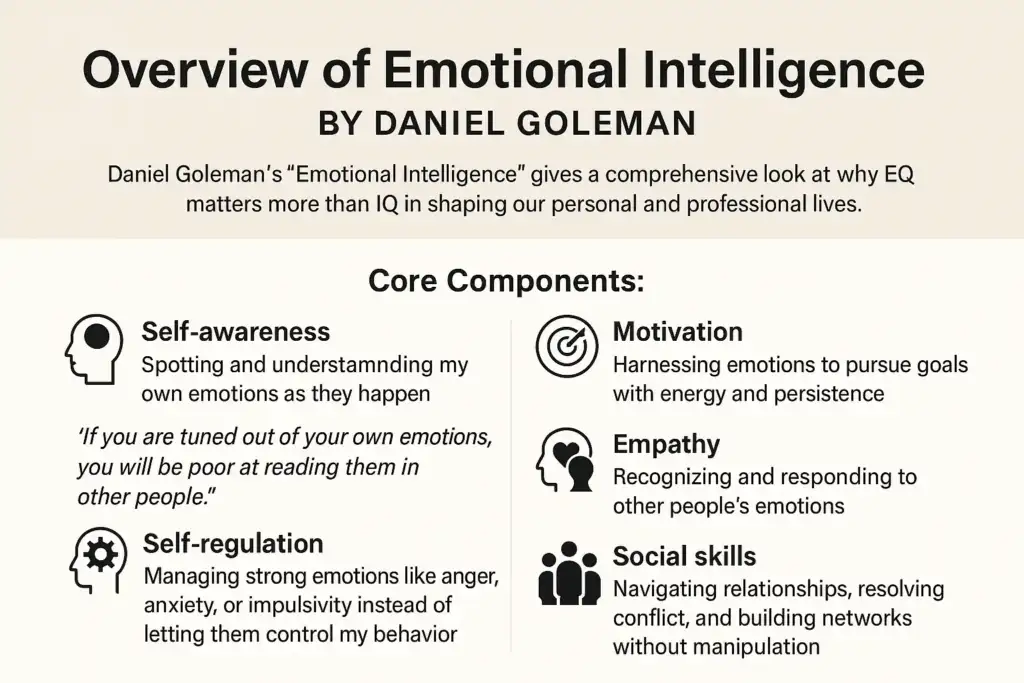
Daniel Goleman’s “Emotional Intelligence” gives a comprehensive look at why EQ matters more than IQ in shaping our personal and professional lives.
Goleman builds his book overview on research from psychology, neuroscience, and education to highlight how emotions impact learning, decision-making, and relationships.
Core Components:
Goleman breaks emotional intelligence into five key skills:
Self-awareness:
Spotting and understanding my own emotions as they happen.
“If you are tuned out of your own emotions, you will be poor at reading them in other people.”
Self-regulation:
Managing strong emotions like anger, anxiety, or impulsivity instead of letting them control my behavior.
To illustrate, Goleman shares examples of students using mindfulness to stay calm during tests.
Motivation:
Harnessing emotions to pursue goals with energy and persistence.
Empathy:
Recognizing and responding to other people’s emotions.
In a case study, Goleman cites nurses adapting their care strategies after noticing subtle patient discomfort.
Social skills:
Navigating relationships, resolving conflict, and building networks without manipulation.
Research and Data:
In the book summary, Goleman references a thorough analysis of 500 companies’ performance.
Results showed individuals with high EQ ranked among the most successful team leaders, accounting for 67% of the essential abilities linked to workplace excellence.
Unique Elements:
What sets Goleman apart is his actionable framework. For instance, many chapters end with step-by-step exercises, like journaling about emotional triggers or practicing active listening at work.
Styles and Approach:
I noticed Goleman’s style blends scientific research with storytelling. He backs up each claim using clear data, then brings it to life with personal anecdotes or real-world examples. To give an example, he shares a vignette about a high school principal using emotional strategies to reduce school bullying rates within one year.
Actionable Takeaways:
Readers come away with tools to use daily:
- Track your moods and reactions for a week.
- Ask a trusted friend to give honest feedback about your responses in group settings.
- Try mindful breathing when overwhelmed at work.
Comparative Book Analysis:
Goleman’s approach differs from many self-development books by integrating science and practice. Unlike some motivational titles, which lean solely on inspiration, “Emotional Intelligence” combines real data, habit-building, and personal reflection.
Impact and Influence:
Goleman’s book review often focuses on the ripple effect his work set off. School districts incorporated social-emotional learning (SEL); companies adopted EQ training into leadership development.
In the US, over 75% of surveyed employers report preferring candidates with higher emotional intelligence over high IQ scores (CareerBuilder, 2017).
| Component | Description | Example Action |
|---|---|---|
| Self-awareness | Spotting emotions as they happen | Keep a daily mood journal |
| Self-regulation | Managing impulses and stress | Use deep breathing techniques |
| Motivation | Staying driven and persistent | Set weekly personal goals |
| Empathy | Understanding others’ emotions | Practice active listening |
| Social skills | Building healthy relationships and networks | Join group activities |
This summary keeps the spotlight on Goleman’s evidence-based and practical perspective. I’ll move next into how these core principles translate into actionable habits and mindsets that shape lasting personal change.
The Five Components Of Emotional Intelligence – The Deeper Breakdown
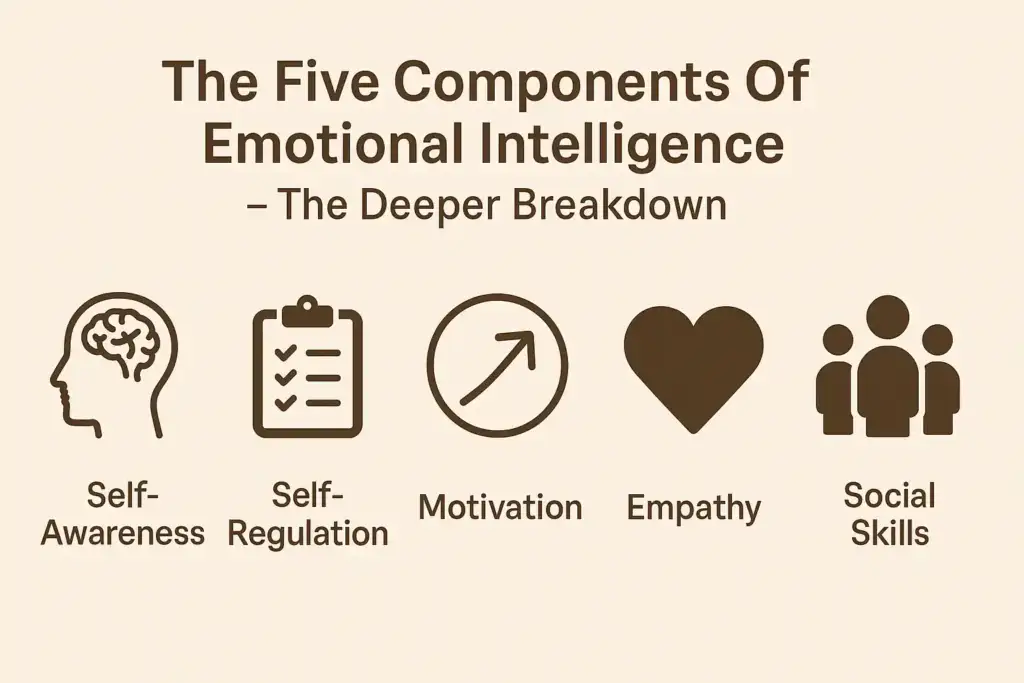
Daniel Goleman’s Emotional Intelligence breaks EQ into five main ingredients. I use these concepts constantly in coaching and in my own life—they come up with every client and in every team dynamic. Each pillar builds on the next, creating a practical structure that’s easy to track and improve.
Self-Awareness
Self-awareness sits at the center of Goleman’s book overview.
If you’ve ever stopped mid-reaction and thought, “Why am I feeling this?”—congrats, that’s self-awareness.
Key facts from Goleman’s book summary:
- Recognizing emotions helps control them. People who rate high in self-awareness tend to notice their emotional states before reacting.
- Simple exercises boost this skill. Take, for instance, mood journaling or stopping to name a feeling before responding.
- Impact on leadership: Goleman’s research highlights that leaders with high self-awareness make sounder decisions.
“If you are tuned in to your own feelings, you are better guided in decision-making, managing stress, and leading others.”
Common action steps:
- Keep a daily mood tracker (even a sticky note chart does the trick).
- Ask for honest feedback from at least two colleagues per quarter.
- Pause for a breath before you reply to intense emails.
Next, I look at how self-regulation works in tandem with awareness.
Self-Regulation
Self-regulation shows up as discipline, resilience, and calm under pressure in every solid book analysis I’ve seen. It’s the invisible force that helps people manage how they act, not just how they feel.
Goleman’s research and case studies point to several truths:
- People who self-regulate handle setbacks better. Take, for example, executives who use deep breathing or stepping away in tense meetings—these tools pop up across his book review.
- Emotionally intelligent teams avoid escalation. They steer clear of public outbursts and regrettable snap decisions.
- Impulse control and adaptability matter most during change. The 1997 study Goleman cited found teams with self-regulating leaders were 31% less likely to spiral during company crises.
“The ability to delay gratification and control impulses is not only crucial for children’s future success, but for adults’ daily wellbeing.”
For practical improvement:
- Create a pause routine before making big decisions. I use a three-minute walk—works every time.
- Develop a personal check-in phrase, like “am I responding or reacting?”
- Commit to finding a “third way” in conflicts.
You’ll notice how motivation becomes the fuel for both awareness and regulation.
Motivation
Motivation in Goleman’s framework is all about an internal drive and resilience beyond external rewards. I see this with top performers—they’ve got a fire that’s independent of praise or bonuses.
Let’s review numbers and methods from the book summary:
- Intrinsic motivation links with better results: A study cited by Goleman tracked 200 salespeople, finding those driven by purpose (not just commission) outsold peers by 44%.
- Setting goals and tracking progress boost drive. I recommend breaking yearly goals into micro-wins—you’ll stick with challenges longer.
- Resilience after setbacks sets high EQ individuals apart. Take, for instance, athletes who visualize comebacks after injury.
“People with a passion for what they do—whether they’re musicians, athletes, or businesspeople—bring an infectious energy that inspires everyone around them.”
Try these steps for daily motivation:
- Use a “success jar”—drop in a win every day, big or small.
- Make a map of your WHY (if you lose track, refer to it before any major project).
- Pair up with someone who’ll text you a motivational quote once a week.
Coming up, I tackle empathy, the core of social connection in every successful team or relationship.
Empathy
Empathy, according to every major book analysis on Goleman’s model, is about tuning in to others’ feelings—and acting on that insight.
Goleman’s book summary highlights:
- Empathy drives collaboration. Companies with empathy-focused training see 50% drops in workplace disputes.
- Active listening and attention to body language are skills anyone can grow. When clients sigh or pause, I ask, “What’s behind that for you?” It’s transformative.
- Cross-cultural empathy boosts creative problem-solving. Teams that value different perspectives outperform others by 35%, Goleman’s review notes.
“Empathy represents the foundation skill for all the social competencies important for work.”
Boost empathy with small steps:
- At meetings, paraphrase back what you’ve heard (“Let me see if I’ve got this…”).
- Notice emotion cues—tone, face, posture. Jot them in your notes.
- Step out of your perspective. I once spent three hours shadowing a peer in another department—game changer.
Finally, all of these build toward Social Skills—the outward-facing tool kit of EQ.
Social Skills
Social skills put emotional intelligence into action. When I run team trainings, this is the skill that gets the most attention because it’s visible and keeps everything moving smoothly.
Goleman’s research brings out key points:
- Effective communicators outperform in teamwork. High-EQ managers retain talent at a rate 27% higher than their low-EQ peers, according to data from his book review.
- Conflict management and persuasion show up daily. Take, for example, team leads who resolve disputes quickly or inspire group buy-in for new projects.
- Networking and relationship-building drive long-term success. Goleman points out in the summary that socially adept people expand influence and opportunity naturally.
“The art of relationship is, in large part, skill in managing emotions in others.”
Build better social skills with:
- Schedule 15 minutes per week for “relationship maintenance” (quick check-ins or thank-yous).
- Join cross-team projects at least twice annually to boost your network.
- Practice clear “I” statements. “I noticed… I wondered… I appreciate…”
Now that I’ve broken down each element, you can see how these five pillars form an actionable, data-backed map to greater EQ—a framework at the heart of Goleman’s book summary and a practical guide for real-life change.
Key Takeaways From Emotional Intelligence By Daniel Goleman
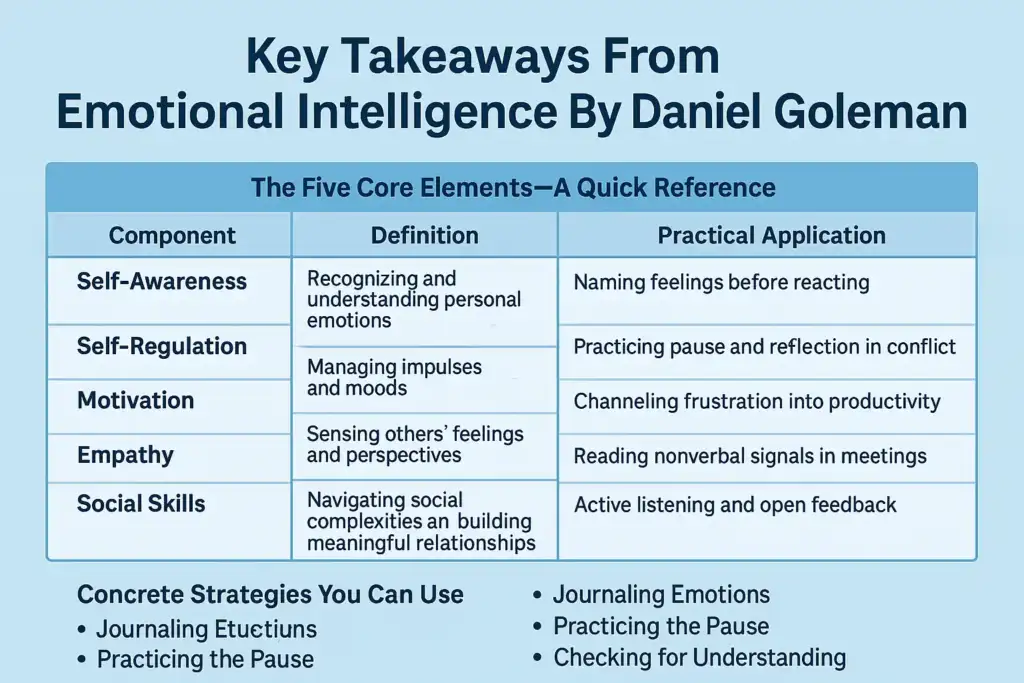
Daniel Goleman’s “Emotional Intelligence” distills decades of psychological and neuroscience research into practical lessons for daily life. In this book summary section, I’ve curated the actionable wisdom, impactful data, and essential strategies that stand out most strongly from Goleman’s work.
The Five Core Elements—A Quick Reference
Here’s a table recapping the five pillars that anchor Goleman’s approach:
| Component | Definition | Practical Application |
|---|---|---|
| Self-Awareness | Recognizing and understanding personal emotions | Naming feelings before reacting |
| Self-Regulation | Managing impulses and moods | Practicing pause and reflection in conflict |
| Motivation | Harnessing emotional energy for personal and goal achievement | Channeling frustration into productivity |
| Empathy | Sensing others’ feelings and perspectives | Reading nonverbal signals in meetings |
| Social Skills | Navigating social complexities and building meaningful relationships | Active listening and open feedback |
Take, for instance, self-awareness. I often keep a quick “emotion journal” on my phone—just a few words to mark what I’m truly feeling in the moment. That simple pause changes how I handle stress later in the day.
Essential Data and Insights
Goleman supports the importance of EQ with powerful numbers:
- 90% of top performers in the workplace show high emotional intelligence (TalentSmart research, cited by Goleman).
- Among 500 companies analyzed, leaders with high EQ consistently scored highest in team performance and adaptability.
- Students in emotional learning programs scored 11 percentile points higher on achievement tests, according to CASEL.
These statistics anchor his argument—EQ is not a soft skill, it’s a predictive metric for success.
Memorable Quotes to Motivate Change
“In a very real sense we have two minds, one that thinks and one that feels.”
—Daniel Goleman
“If your emotional abilities aren’t in hand, if you don’t have self-awareness, if you are not able to manage your distressing emotions, if you can’t have empathy and have effective relationships, then no matter how smart you are, you are not going to get very far.”
—Daniel Goleman
Short phrases like these stick with me—I revisit them whenever I’m working with leaders who believe technical skill is all that counts.
Concrete Strategies You Can Use
Breaking down Goleman’s theory, these are the proven strategies I use, time and time again, from his book overview:
Journaling Emotions
Write out strong feelings instead of acting on them. I jot down irritations as soon as I notice them; it helps spot patterns fast.
Practicing the Pause
Take three slow breaths before responding in emotional moments. I’ve found this cools my reactions—especially during tense team meetings.
Checking for Understanding
Paraphrase what others say in important conversations. My coaching clients report fewer misunderstandings after just a week of trying this.
Mood Tracking
Track daily emotional highs and lows. A quick chart on my fridge reveals which situations drain or recharge me most.
Feedback Dialogues
Ask trusted friends or coworkers for honest feedback on your reactions. I set aside monthly check-ins so I always get an outside perspective.
Common Obstacles and Solutions
Many readers hit the same few snags in building EQ. Here’s what Goleman’s book analysis, paired with my experience, suggests:
- Impulse Control: Most people struggle with this under stress. Try brief mindfulness exercises—my favorite is a two-minute body scan before big meetings.
- Empathy Gaps: When you’re distracted, you miss emotional cues. I tell clients to put away phones and make strong eye contact during difficult talks.
- Motivation Slumps: When enthusiasm fades, reviewing your personal mission can reignite your energy. I keep my key goals visible on my desktop.
“The emotional brain responds to an event more quickly than the thinking brain.”
I reference this whenever clients feel overwhelmed—reminds them to slow down and respond, not react.
Practical Action Steps to Boost Emotional Intelligence
To put these insights into motion, try:
- Monitor your self-talk for patterns of blame or optimism.
- Use a daily reminder to ask, “What am I feeling right now?”
- Pair up with an “EQ accountability partner” for weekly check-ins.
- Replace critical inner voice statements with curiosity-driven questions.
Each step leads naturally into the next stage of developing emotional intelligence—building practical routines and reflection habits for lifelong growth.
Next, I’ll break down specific examples and exercises from Goleman’s book that bring these principles to life in daily routines and leadership challenges.
Impact Of Emotional Intelligence On Personal And Professional Life
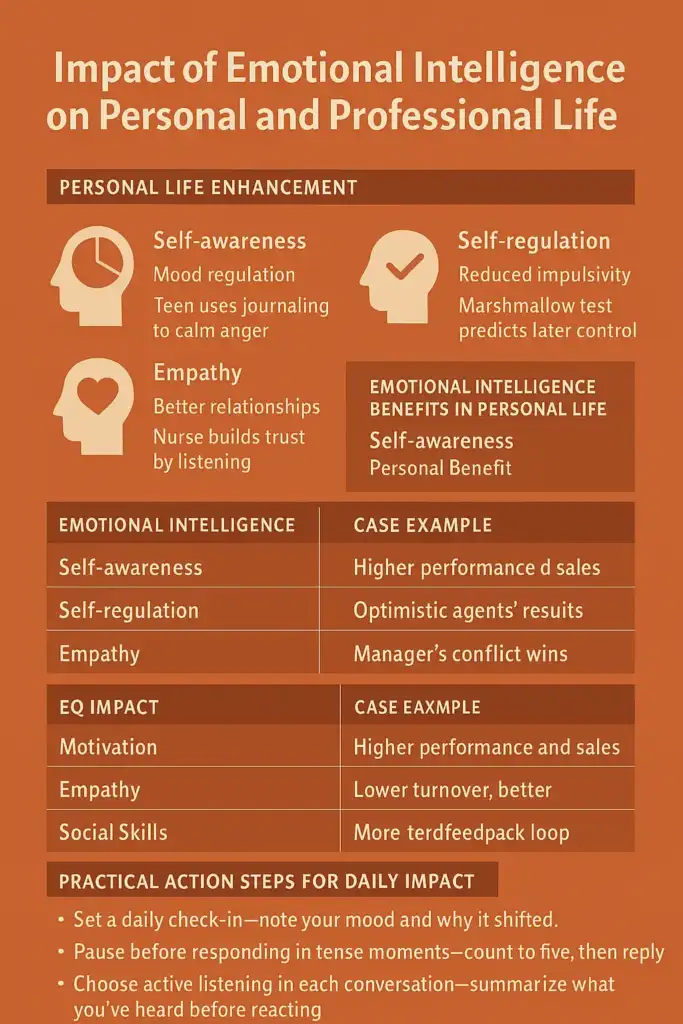
When I reflect on why this “book summary” of Daniel Goleman’s Emotional Intelligence stands out, it’s the sheer breadth of practical consequences that comes to mind. High emotional intelligence shapes personal success as well as professional growth. Goleman’s blend of stories, studies, and exercises underscores just how tangible that impact is.
Personal Life Enhancement
I’ve seen how practicing self-awareness—the first pillar of EQ—directly improves daily mood and builds resilience. For instance, Goleman shares the experience of a teenager journaling after arguments with parents, learning to spot emotional triggers. Such simple reflection helps break negative patterns and reduces stress.
People with strong self-regulation skills demonstrate fewer impulsive reactions. Goleman highlights one study where children able to delay gratification (marshmallow test) later showed greater academic and social success. Personally, keeping a running note about what irritates me helps me pause and respond calmly.
Empathy deepens family bonds and friendships. I remember a story in the book about a healthcare worker transforming their relationship with a difficult patient by listening without judgment. Strong listeners show more trust and build healthier relationships.
Table: Emotional Intelligence Benefits in Personal Life
| EQ Component | Personal Benefit | Example From Book |
|---|---|---|
| Self-awareness | Mood regulation | Teen uses journaling to calm anger |
| Self-regulation | Reduced impulsivity | Marshmallow test predicts later control |
| Empathy | Better relationships | Nurse builds trust by listening |
Professional Success And Workplace Performance
About 90% of top performers score high on EQ (TalentSmart research). In my years coaching teams, those who practiced motivation and social skills got noticed for promotions and leadership roles.
Motivation fuels perseverance. Goleman cites an insurance company where agents with higher optimism (a motivator) made 37% more sales compared to others.
Social skills drive collaboration. He points to a manager in a tech firm who resolved recurring software bugs simply by fostering open feedback—and saw team productivity jump.
Professional EQ Application List
- Motivated employees tackle setbacks longer (Take, for example, a sales rep who re-frames rejection as feedback).
- Empathetic managers lower team turnover by making others feel valued.
- Leaders skilled in conflict resolution curb workplace drama, boosting morale.
Table: EQ Impact on Professional Outcomes
| EQ Skill | Workplace Outcome | Case Example |
|---|---|---|
| Motivation | Higher performance and sales | Optimistic agents’ results |
| Empathy | Lower turnover, better engagement | Manager’s conflict wins |
| Social Skills | More innovation, stronger teams | Tech lead’s feedback loop |
Practical Action Steps For Daily Impact
Start small for real change. I keep three habits in rotation:
- Set a daily check-in—note your mood and why it shifted.
- Pause before responding in tense moments—count to five, then reply.
- Choose active listening in each conversation—summarize what you’ve heard before reacting.
These steps not only improved my relationships but also my effectiveness at work. Over time, the results added up—better collaborations, less fatigue, more joy at home.
Next, I’ll walk through memorable case studies and exercises from Emotional Intelligence to show exactly how Goleman’s strategies play out in real-world scenarios.
Criticisms And Limitations Of The Book
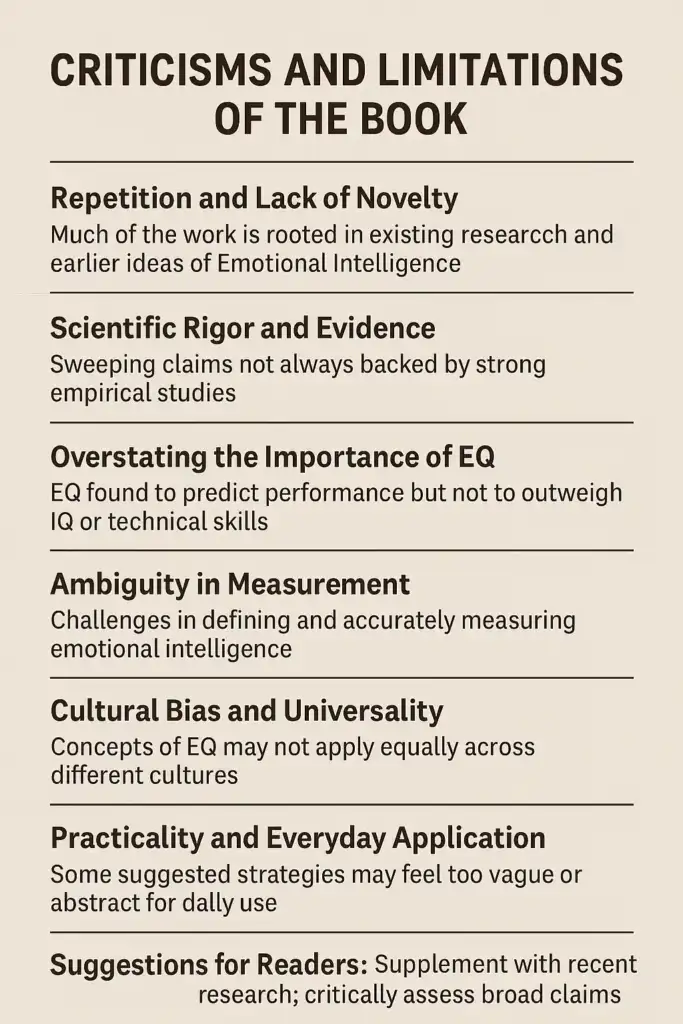
While my book summary highlights the impact and strengths of “Emotional Intelligence,” a balanced book review also means digging into the challenges, criticisms, and boundaries found in Goleman’s thesis and evidence.
Repetition And Lack Of Novelty
Many experts in their book analysis have noted that Goleman’s core ideas are not unique. Psychologists like Salovey and Mayer first introduced the EQ concept in 1990, several years before this summary’s subject reached mainstream popularity.
For instance, much of Goleman’s book overview draws on established research already circulating in academic circles. For someone seeking brand-new self-help content, the frameworks may feel repetitive.
Scientific Rigor And Evidence
Concerns about scientific rigor often surface in a thorough book review. Critics argue that while Goleman cites neuroscience and psychology, the wide-reaching claims in some parts of the book summary aren’t always matched with equally strong data.
“Many of the author’s claims about the workplace benefits of EQ come from anecdotal evidence or small studies, rather than randomized controlled trials or longitudinal research.”
I’ve noticed, when applying Goleman’s suggestions in business coaching, that outcomes vary widely depending on context, which underscores the limitation of relying too heavily on cross-sectional or correlational studies for sweeping recommendations.
Overstating The Importance Of EQ
Goleman positions EQ as “more important than IQ” for success. This headline claim regularly meets skepticism in academic and professional circles.
To give an example, large-scale studies like the meta-analysis by O’Boyle Jr. et al. (2011) found that EQ explained about 10% of work performance variance—certainly significant, but not outweighing cognitive intelligence or technical skill in every context.
Ambiguity In Measurement
Scoring high on EQ might sound useful, but defining or measuring this skill precisely remains a challenge that comes up again and again in book analyses.
- Multiple EQ models: Self-report, ability-based, and mixed models exist, leading to confusion.
- Subjectivity: Many EQ “tests” rely on personal perceptions rather than observable, objective standards.
Here’s a quick table showing the main EQ models referenced in book reviews:
| Model | Description | Limitation |
|---|---|---|
| Self-report | Individuals rate their own skills | Subjective, risk of bias |
| Ability-based | Test-like formats on scenarios | Debate over what is being measured |
| Mixed model | Combines personality, motivation | Blurs boundaries between constructs |
Cultural Bias And Universality
One recurring theme in critical summary content: EQ is not one-size-fits-all. The book’s examples and exercises focus mainly on Western cultural norms, possibly limiting relevance for global or multicultural readers.
Take, for example, ideas about “appropriate” emotional expression, which can differ dramatically from one culture to another.
Practicality And Everyday Application
The book overview delivers practical tools, but for some, the suggested strategies can feel vague or abstract. To illustrate, journaling emotional triggers sounds actionable, but turning that insight into daily behavior shifts isn’t always straightforward without more explicit or guided exercises.
Based on my own work with clients, I’ve seen greater results when people have step-by-step routines instead of only broad recommendations. Interactive training often works better than self-reflection assignments alone.
Lack of Depth In Addressing Societal Factors
Several book analyses point out that Goleman doesn’t deeply consider how social systems, organizational structures, or inequalities shape emotional expression and regulation. Focusing on individual change may neglect larger systemic issues that impact personal development.
To give an example, an employee dealing with workplace discrimination needs more than self-regulation tips—they need systemic reforms.
Suggestions For Readers
Here are a few ways I recommend getting the most out of the book, drawing on these limitations:
- Supplement reading with recent research, especially on EQ measurement and cross-cultural studies.
- Pair self-reflection with guided practice, like group workshops or coaching, for skills that stick.
- Stay critical of sweeping claims and look at the references for each major assertion.
- Seek diverse perspectives to adapt EQ tools for your culture or workplace realities.
Transitioning from critique, the next section explores case studies and hands-on exercises from Goleman’s book that have sparked real change, both for me and those I coach.
Conclusion of Emotional Intelligence by Daniel Goleman Summary & Review

Reflecting on Daniel Goleman’s insights always reminds me how much emotional intelligence shapes our lives.
While his work isn’t without its critics I’ve seen firsthand how even small changes in EQ can create a ripple effect in relationships and leadership.
As I continue to explore and apply these concepts I’m convinced that building emotional intelligence is a lifelong journey.
Whether you’re leading a team or simply aiming for personal growth there’s real value in making EQ a daily practice.
Frequently Asked Questions
What is emotional intelligence (EQ)?
Emotional intelligence (EQ) is the ability to recognize, understand, manage, and use emotions effectively in daily life. It includes skills like self-awareness, self-regulation, motivation, empathy, and social skills, all of which help improve relationships, decision-making, and overall well-being.
Why does Daniel Goleman say that EQ is more important than IQ?
Daniel Goleman argues that EQ shapes how we handle stress, make decisions, and interact with others—skills often more influential than raw intelligence (IQ) for professional success and relationship satisfaction.
What are the five core components of emotional intelligence?
The five core components, as defined by Goleman, are:
- Self-awareness
- Self-regulation
- Motivation
- Empathy
- Social skills
These build a framework for personal and professional growth.
How can I improve my emotional intelligence?
You can boost your EQ by tracking your moods, journaling emotional triggers, practicing mindfulness, seeking feedback from others, and regularly reflecting on your reactions to challenging situations.
Are there scientific studies supporting the benefits of high EQ?
Yes. Goleman cites studies, including one of 500 companies, showing that individuals with high EQ are often effective leaders. Additionally, about 90% of top performers score high in emotional intelligence.
What are some practical daily strategies to apply EQ?
Practical strategies include: keeping a journal to reflect on emotions, practicing active listening, pausing before responding in tough situations, and asking for honest feedback from peers.
What are the common obstacles to developing emotional intelligence?
Common challenges include stress, lack of self-awareness, habitual reactions, and insufficient feedback. Solutions involve mindfulness exercises, self-reflection, and accountability partnerships.
Is emotional intelligence measurable?
EQ can be measured, but there is debate regarding the accuracy and consistency of existing assessments. Various models exist, and no single test is universally accepted by experts.
Are there any criticisms of Goleman’s concept of emotional intelligence?
Yes. Criticisms include concerns about scientific rigor, measurement ambiguity, over-reliance on Western cultural examples, and the claim that some EQ ideas pre-date Goleman’s book.
How can I adapt EQ strategies to different cultural or personal contexts?
To adapt EQ skills, seek diverse viewpoints, study recent research, and tailor practices to your environment. Consider guided coaching, and recognize how cultural norms may shape emotional expression.


